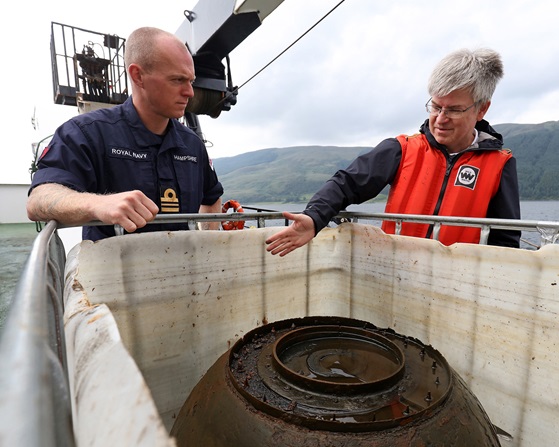Royal Navy Divers Recover Famed "Bouncing Bombs"
A team of Royal Navy clearance divers from the Faslane-based Northern Diving Group (NDG) have assisted in the recovery of World War II-era “bouncing bombs” from the bottom of Loch Striven. On Wednesday, three of the famous “Highball” bombs broke the surface of the Argyll Loch for the first time in over 70 years. They were among an estimated 200 of the Barnes Wallis designed munitions tested on the loch ahead of the famous Dam Busters raid in 1943.
“Northern Diving Group are delighted to assist in this fascinating initiative,” said Lieutenant Commander Tony Hampshire, Commanding Officer of the diving group. “We welcome the opportunity to provide our mine-lifting and recovery expertise to preserve this piece of history.”
The expert Royal Navy divers and bomb disposal experts were first contacted about the initiative in 2015 when Dundee University lecturer Dr. Iain Murray got in touch seeking their help in recovering the bouncing bombs.
Dr Murray, who is the author of “Bouncing-Bomb Man: the science of Sir Barnes Wallis”, has spent the last decade trying to find a way of raising the bombs from the loch, which lies off the Firth of Clyde about 30 miles west of Glasgow. A few years ago, a friend put him in touch with Mark Paisley, the British Sub-Aqua Club’s North West Regional Coach, and the doctor soon enlisted his help in surveying the loch to track down the bombs. They were eventually located in 35m and 55m of water.
Although the munitions were used for test purposes and are thought not to contain explosives, the Northern Diving Group experts were enlisted to dive to the bombs to check them, give the all clear, and then raise them to the surface.
Attaching specialist lifting equipment to the heavy metal Highballs, the NDG team then winched them out the water and onto their workboat the “Cato”. After being secured they were then moved to shore ready for transport in wet tanks containing a special salt-water solution to prevent them from corroding.
 Commanding Officer of NDG Lieutenant Commander Tony Hampshire examines one of the Highball bombs with Dr Iain Murray from Dundee University
Commanding Officer of NDG Lieutenant Commander Tony Hampshire examines one of the Highball bombs with Dr Iain Murray from Dundee University
The concept of the bouncing bomb was first described by engineer Sir Barnes Wallis in 1942 and was originally envisioned for use by the Fleet Air Arm. However, in November 1942 the project was split into two strands – codenamed “Highball” and “Upkeep” – with one weapon designed for use against ships and the other, heavier, Upkeep bombs for targeting dams. It was the Upkeep bombs that were finally used in Operation Chastise, the daring RAF Dam Busters raid in 1943 on the Mohne, Edersee and Sorpe Dams.
The unique design of the bombs meant they could skip over the surface of the water, avoiding anti-torpedo nets and defences, to hit their targets. Many of the spherical Highball bouncing bombs were tested on Loch Striven, with bombers from RAF Turnberry flying up the loch to bounce their bombs towards old ships which were used as targets.
Footage from the tests was gathered for analysis by photographers from the Marine Aircraft Experimental Establishment (MAEE) at RAF Helensburgh and was eventually seen by hundreds of thousands of people after it was used in the 1955 film “The Dam Busters”.
The project to raise the Highball bombs is an important one as there are currently no examples on public display. The recovered munitions will eventually be homed in the Brooklands Museum in Surrey and de Havilland Aircraft Museum in Hertfordshire in time for the 75th anniversary of the Dam Busters raid next year.
Chief Petty Officer Gareth Spence, who led the Northern Diving Group descent to recover the bombs, said: “It was a privilege to be part of this dive. Northern Diving Group deals with dozens of items of Wartime ordnance around the country each year, but the raising of the Highball bombs has been a real highlight.”
The opinions expressed herein are the author's and not necessarily those of The Maritime Executive.
